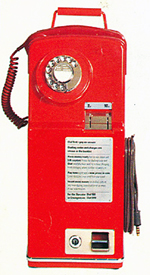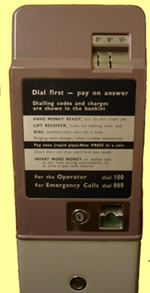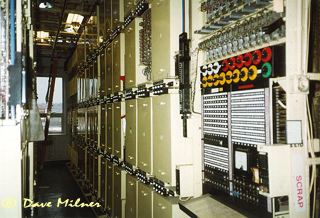The 'Dial Everywhere' Network
 |
Today, it's as easy to call abroad as it is to call someone in your own town and the term 'long distance' or 'trunk call' no longer has any significant meaning. However, it was not until 1979 that the 'Dial Everywhere Network' was completed, which enabled (UK) 'trunk calls' to be dialled directly by the telephone subscriber, without the assistance of an operator. |
In the 21st century, landlines (of telephone subscribers) are generally rented with inclusive call packages which allow calls to any UK subscriber of up to one hour duration without further charge. Consequently, it is somewhat difficult to comprehend that charging by distance and duration were once so important to:
Restrict call traffic (to the network) and to keep costs (to the subscriber) under control.
Introduction
Prior to 1958, all trunk calls were manually connected by an operator. However, on 5th December of that year, Her Majesty the Queen made the first STD call and Subscriber Trunk Dialling was born. The full introduction was planned in two phases. The first was to allow the automatic dialling of the majority of calls, the second was to complete the Transit Network which made possible the automatic routing of all calls. It was not until 21 years later, in 1979, that the 'Dial Everywhere Network' was completed and STD had come of age.
The first STD call was made by Her Majesty the Queen on 5th December 1958 to 031 CAL 3636, the Lord Provost of Edinburgh.
Local Calls
Before STD was introduced, local call charges were based upon the radial distances between exchanges and a measuring point was determined for every exchange in the country. Calls up to 15 miles, point to point, could be dialled direct, were untimed, and the following unit charges were automatically recorded on the subscribers' meter:
| Distance |
0-5 Miles |
5 -7.5 Miles |
7.5-12.5 Miles |
Over 15 Miles |
|||||||||||||||||
| UNITS |
|
|
|
|
|
|
|
|
|
|
|
|
|
|
|
|
|||||
The meter pulses were calculated from the code digits used to route the call.
...& Manual Trunks
All calls over 15 miles were classed as Trunk Calls, had to be connected via the operator (by dialling O) and were charged by both distance and duration. Charges for operator calls were raised by means of a ticket prepared by the operator.
The Basic Network for Operator Controlled Calls:
| Dependent | - | Minor | - | Group | - | Zone | - | Zone | - | Group | - | Minor | - | Dependent |
| 7 Links (maximum) end to end | ||||||||||||||
The schematic above forms the Basic Network in the Manual Trunk System, a maximum of 7 links are necessary to connect a call. Further, auxiliary routes are provided as the traffic between exchanges justifies.
Zones
The UK was divided into 18 Zones, each one having a Zone Centre to handle all the long distance traffic into and out of the area. All Zones, except Belfast and Tunbridge Wells were fully interconnected.
Groups
Larger exchanges acting as a Group Centre for an area of minor exchanges. Thus the Zone Centres and Group Centres were fitted with all the control, timing and supervision equipment necessary for the manual connection of trunk calls. Later on the Group Centres were renamed Trunk Group Centres.
Minors
An exchange having direct connections to the Trunk Group Centre.
Dependents
An exchange dependent upon a Minor exchange for its long distance communication.
Network Master Plan
Trunk Mechanization lead to the provision of Non-Director switching units to every Zone Centre and Trunk Group Centre to deal with all incoming, outgoing and through trunk traffic. This enabled an operator to connect any call entirely by automatic means.
In 1947 there were 18 Zone Centres and 175 Trunk Group Centres. There were still many manual exchanges in the network but, an increasing number of automatic exchanges. In 1957 a 'White Paper' for a network master plan was devised to simplify charges and convert automatic exchanges to STD working, but a radical change in the charging structure was needed before STD could be introduced...
Group Charging replaced the more cumbersome point-to-point method. The 6000 or so exchanges were divided into 639 Charge Groups (633 Non-Director and 6 Director) each covering an area of approximately 150 square miles.
Local calls were now any calls made within the home charging group and calls to an adjacent group. An exception to this rule was borders formed by natural boundaries, such as rivers or mountains, in which case the areas were deemed to be non-adjacent or contiguous and thus charged at a trunk call rate. (This anomaly, which applied particularly in rural areas, was finally abolished when new charges came into force on 12th January 1974).
Trunk calls were all others.
STD - Phase 1 - The Auxiliary Network
Transit Network
The EquipmentPublicity & Education
References
Britain's Original STD Codes by Selwyn Horne and Andy Emmerson, from Telecom Heritage Journal Issue 9A, Spring 1989.
Post Office Telecommunications Journal Spring 1959.
Rob Grant's Telephone Pages where a large collection of tones can be found.
All logos and trade marks are the property of their respective owners and are used on the Light Straw site(s) for review only. Students and researchers are recommended to make their own independent enquiries as to the accuracy of the information contained therein.



